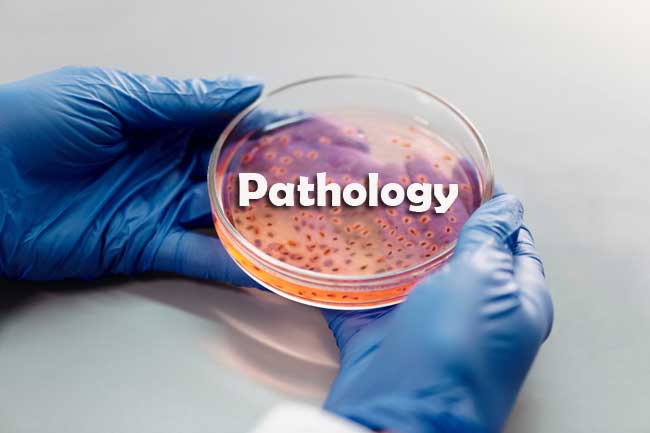Pathology Model Question
Pathology Model Question Papers Free Pdf is available. Download Pathology Model Papers from the below attachments for free of cost. Pathology Model Papers will definitely helpful for the aspirants to get an idea about the previously asked questions.

Here we provided Model Question Papers of Pathology. Pathology Model Papers is given below. The Aspirants who applied for the latest Pathology Recruitment for can check the Pathology Exam Model Papers and Study Material in the sections below.
Model Question on Pathology
1. Stain used for demonstration of Reticulocyte is
(1) Giemsa stain
(2) Wright stain
(3) Brilliant Cresyl blue
(4) Alcian blue
2. Fresh Frozen Plasma (FFP) stored at Blood Bank for
(1) 35 days
(2) 60 days
(3) 3 months
(4) 1 year
3. In anemergency situation in which the patient is at risk for death from blood loss, if transfusion is delayed, which blood product may be released without compatibility testing ?
(1) Frozen deglycerized RBCs
(2) Irradiated Blood
(3) RBCs lacking high incidence antigen
(4) Group ‘O’ Rh negative RBCs
4. Fresh Frozen Plasma (FFP) is most appropriate for which of the following situation ?
(1) Severe accident with chest trauma and suspected internal bleeding.
(2) As a_ nutritional source in a severly cachectic patient
(3) Gastro-intestinal haemorrhage with abnormally elevated PT and APTT.
(4) As a Plasma expander in a patient with severe burn.
5. Aplastic Anaemia can progress to all, except :
(1) Acute Mycloid Leukaemia (AML)
(2) Myclo Dysplastic Syndrome (MDS)
(3) Pure red cell aplasia
(4) Paroxysmal nocturnal Haemoglobinuria (PNH)
6. All of the following may Cause severe | thrombocytopenia, except :
(1) A markedly enlarged spleen
(2) Von Willebrand’s disease
(3) Massive blood transfusion
(4) Disseminated intravascular coagulation
7. Mutation characteristic for Polycythaemia vera is
(1) JAK 2 Mutation
(2) Ber-abl Mutation
(3) p53 Mutation
(4) RAS Mutation
8. Pseudo Pelger — Huet Cells are seen in
(1) Hodgkin’s Lymphoma
(2) Multiple Myeloma
(3) Non-Hodgkin’s Lymphoma
(4) Myelodysplastic Syndrome
9. Auer rods are derived from
(1) RNA
(2) DNA
(3) Azurophilic granules
(4) Secondary granules
10. Haemolytic disease of new borne (HDN) occurs when
(1) Mother Rh +ve foetus Rh —ve
(2) Mother Rh —ve foetus Rh +ve
(3) Both mother and foetus Rh —ve
(4) Both mother and foetus Rh +ve
11. Which of the following metabolic abnormality is seen in Multiple Myeloma ?
(1) Hypercalcaemia
(2) Hypernatraemia
(3) Hyperkalaemia
(4) Hyperphosphataemia
12. Which is NOT a reducing sugar in Urine ?
(1) Glucose
(2) Galactose
(3) Sucrose
(4) Fructose
13. If Urine is kept for a long time
(1) Becomes Black
(2) Urea increases
(3) Urea decreases
(4) Creatinine increases
14. Five ml of a coloured solution has an absorbance of 0.500. The absorbance of 10 ml of the same coloured solution will be
(1) 1.000
(2) 0.500
(3) 0.250
(4) 0.800
15. The enzyme used as a marker for alcohol abuse is
(1) Gamma glutanyl transferase
(2) Alanine Amino transferase
(3) Aspartatic amino transferase
(4) Alkaline Phosphates
16. Markedly decreased blood levels of which one of the following substances are most characteristic of Intravascular haemolysis ?
(1) Bilirubin
(2) Haptoglobin
(3) Methemoglobin
(4) Lactate Dehydrogenase
17. Hypernatraemia occurs in all of the following, except :
(1) Cushing disease
(2) Dehydration
(3) Hypothalaemic injury
(4) Haemorrhage
18. The cell of origin of meningioma is
(1) Dura mater
(2) Arachnoid cap cell layer
(3) Pia mater
(4) Choroid plexus
19. Bile duct obstruction can be diagnosed by
(1) Asparate Transaminase (AST)
(2) Total Bilirubin
(3) Bilirubin in Urine
(4) Ester bilirubin
20. Which of these is not a Ketone body ?
(1) Acetone
(2) Aceto acetic acid
(3) β—Hydroxy butyric acid
(4) Butyric acid
| Mock Test | Practice Set |
| Important Questions | Quiz |
| Sample Papers | MCQ |
| Model Question | Questions and Answers |
21. Two days after receiving antimalarial drug primaquine a 27-years-old man develops Intravascular haemolysis resulting in decreased haematocrit, haemoglobinaemia and haemoglobinurea. Examination of Peripheral Blood Film (PBF) shows bite cells. | The most likely diagnosis is :
(1) Hereditary Spherocytosis (HS)
(2) Glucose-6-Phosphate Dehydrogenase deficiency (G6PD)
(3) Paroxysmal Nocturnal Haemoglobinuria (PNH)
(4) Auto Immune Haemolytic Anaemia (AIHA)
22. The stain used for demonstration of neuroglial tissue, except :
(1) Phospho tungastic acid haemotoxylin (PTAH)
(2) Holzer stain
(3) Cajal’s gold sublimate
(4) Masson’s Trichome
23. Insulin dependent glucose uptake is NOT seen in
(1) Skeletal muscle
(2) Heart
(3) Adipose tissue
(4) Kidney
24. Beri Beri is caused due to deficiency of
(1) Vitamin B1
(2) Vitamin B2
(3) Vitamin E
(4) Vitamin K
25. Which antibody class has the ability to cross the Placenta ?
(1) IgM
(2) IgG
(3) IgA
(4) IgD
26. High Amylase level in Pleural fluid suggests the diagnosis of :
(1) Tuberculosis
(2) Malignancy
(3) Rheumatoid arthritis
(4) Pulmonary infarction
27. A patient admitted to the hospital for chemotherapy, develops Disseminated Intravascular coagulation (DIC). He received multiple Platelet transfusion but is not responding now to the same. The reason for this platelet refractoriness is :
(1) Neutropenic fever
(2) Sepsis
(3) DIC
(4) HLA immunization
28. Altitude sickness is typically caused due to:
(1) Partial pressure of oxygen
(2) Increased level of CO2 in Blood
(3) Cold temperature
(4) None of these
29. The reagent used for occult Blood test in stool :
(1) Orthodianisidine
(2) Sodium Chloride
(3) Benedict’s reagent
(4) Sodium Nitropruside
30. In immunohistochemistry, the immunozymatic method is based on
(1) Fluorescein
(2) Rhodamine
(3) Auramine
(4) Biotin — Avidin technique
31. Exfoliative Cytology is NOT useful in
(1) Diseases of Cervix
(2) Diseases of Urinary Bladder
(3) Diseases of Liver
(4) Diseases of Stomach
32. Which virus causes the disease COVID-19 ?
(1) SARS — COV — 2
(2) SARS
(3) MERS
(4) Haemophilus Influenza
33. All of the following causes Decrease in Haematocrit, except :
(1) Blood loss
(2) Anaemia
(3) Leukaemia
(4) Polycythaemia Vera
34. Which stain is used in frozen section of Liver tissue for demonstration of fat ?
(1) Mucicarmine
(2) Periodic Acid Schiff (PAS)
(3) Alcian blue
(4) Oil Red O
35. Testing of recipient cells against Donor serum is
(1) Major Cross Match
(2) Minor Cross Match
(3) Direct Coomb’s Match
(4) Rh Group Matching
36. Which Anticoagulant used for coagulation tests ?
(1) EDTA
(2) Sodium Citrate
(3) Sodium Fluoride
(4) Double Oxalate
37. Test for checking mean Plasma Glucose concentration over previous 8 to 12 weeks is
(1) HbAlec
(2) Oral Glucose tolerance test
(3) Fructosamine test
(4) Fasting Plasma Glucose Concentration
38. Which test is not employed for assessment of Glomerular Filtration Rate (GFR) ?
(1) Urea clearance
(2) Innulin clearance test
(3) Creatinine clearance test
(4) Insulin clearance test
39. Abnormal constituent in Gastric juice is
(1) Gastrin
(2) Hydrochloric acid (HCl)
(3) Intrinsic factor
(4) Bile
40. Which type of cast seen in Urine of normal person after strenous exercise ?
(1) Epithelial Cast
(2) Waxy Cast
(3) Hyaline Cast
(4) Granular Cast
41. Condition with low specific gravity of Urine is :
(1) Glycosuria
(2) Albuminuria
(3) Benign Nephrosclerosis
(4) Acute glomerulonephritis
42. Increase in MCHC is associated with :
(1) Iron Deficiency anaemia
(2) Megaloblastic anaemia
(3) Anaemia of chronic disease
(4) Hereditary spherocytosis
43. Western Blot is used for
(1) Protein
(2) DNA
(3) RNA
(4) Sugar
44. Low ESR is seen in :
(1) Sickle Cell anaemia
(2) Hereditary Spherocytosis
(3) Thalassaemia
(4) Microangiopathic haemolytic anaemia
45. Which disease is congenital but not genetic ?
(1) Congenital adrenal hyperplasia
(2) Congenital Syphilis
(3) Marfan’s Syndrome
(4) Huntington disease



